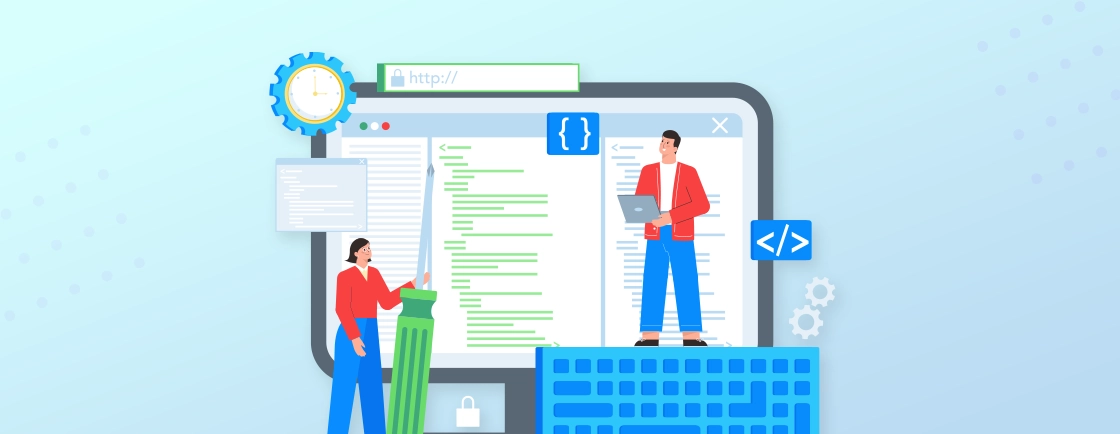Table of Contents
Websites and web apps are a simple way to show who you are or what your business does. People can visit them and use different parts to learn more or do things online.
Web apps are a bit harder to make than regular websites. They take more time and work, but they also give better features and help keep people interested. Developers use tools like JavaScript, CSS, and PHP to build them and make sure they work well.
There are also many other tools that make it easier to create any kind of web app. In this blog, we will talk about those tools and also share the types of web apps that can help your business grow. Let’s get started.
What are Web Applications?
A web application (or web app) is a software program that runs in a web browser. Web apps are delivered on the WWW to users with an active network connection. Web applications are often interactive and provide users with a variety of features and functionality. That includes the ability to create, customize, and edit content, store data, and communicate with other users.
Web applications are typically written using a variety of web development technologies, including HTML, CSS, JavaScript, PHP, Python, Ruby, and Java.
If you are trying to create or customize a web application for your business, it is important to consult with a qualified web development services. They can help you to assess your needs and choose the best solution for your business.
Benefits of Web Application Development
Web applications offer a bunch of advantages over traditional desktop software applications. For example, web applications are typically more accessible, as they can be accessed from any device with a web browser. But there are some other advantages as well.
- Increased reach: Web applications can be accessed by anyone with a net connection, regardless of their location or device. That allows businesses to reach a wide audience and increase their customer base.
- Improved customer service: Web applications can help provide customers with self-service options like online ordering, account management, and support resources. This can stop staff from doing customer service and focus on more complex issues.
- Increased efficiency and productivity: Web applications can be used to automate tasks, streamline workflows, and improve collaboration between employees. This can lead to a better efficiency and productivity and free up employees. So they can focus on more strategic initiatives.
- Reduced costs: Web applications can help businesses reduce costs in a number of ways, such as by reducing the need for paper-based processes, eliminating the need to buy and maintain software licenses, and reducing the need for IT support staff.
- Improved competitive advantage: Web applications can help businesses to differentiate themselves from their competitors by providing innovative features and functionality and by offering a superior customer experience.
Plus, there are improved security measures and analytics tracking. In addition to these general benefits, web applications can also offer a no. of specific benefits depending on the type of application and business.
Types of Web Application Development
Web applications are not all the same. They vary based on how they are built and how users interact with them.
Each type serves a different business need and works best in different use cases.
Below are the most common types of web apps, along with simple examples and where they are best used.
Single Page Applications SPAs
Single Page Applications load everything on one page and update content without reloading. This makes them fast and smooth to use.
They are built with JavaScript frameworks and focus on real time interaction.
Example
Gmail is a common example of an SPA
Used For
- Social media platforms
- Project management tools
- Email services
Why Use
SPAs give a smooth user experience and faster interactions
Multi Page Applications MPAs
MPAs reload the entire page every time you click on a link or go to a new section.
They are best suited for websites that have lots of content and multiple features.
Example
Amazon and LinkedIn use the MPA structure
Used For
- Ecommerce websites
- Blogs and news portals
- Forums
Why Use
Great for large websites with many categories and SEO needs
Progressive Web Applications PWAs
Progressive Web Applications work like mobile apps but run inside your browser. They can work offline and load very quickly.
These apps give a better mobile experience without the need to install anything from the app store.
Example
Twitter Lite is a popular PWA
Used For
- News websites
- Online booking platforms
- Retail businesses
Why Use
Work on all devices and improve the mobile experience
Static Web Applications
Static web apps show the same content to every user. They do not change based on user input or activity.
They are easy to create and work well when you just want to display information.
Example
Basic portfolio websites or company pages
Used For
- Company profile sites
- Documentation pages
- Simple blogs
Why Use
Easy to build and load fast
Dynamic Web Applications
Dynamic apps show different content to different users based on actions or data input.
They connect with databases and can change in real time.
Example
Netflix and YouTube
Used For
- Video streaming platforms
- Online learning websites
- Custom dashboards
Why Use
Better engagement and real time updates
Ecommerce Web Applications
Ecommerce apps are built to help users buy and sell products online.
They include features like product pages, shopping carts, and payment systems.
Example
Flipkart and Shopify based stores
Used For
- Online stores
- Product catalogs
- Retail platforms
Why Use
Built for managing online transactions and inventory
The best type of web application development for a particular project will be based on the specific needs of the project. For example, a simple website with static content may only require static web development. A complex eCommerce website, on the other hand, will likely require dynamic web development and eCommerce web development.
To that end, you can opt for a web development agency, as they’ll analyze your technical and non-technical requirements to suggest you the best web application development option.
How to Develop a Web Application?
A web application will be only as good as the process followed to create it. Here’s how you create a successful web application:
Step 1: First off, you need to define the scope and goals of your web application. What do you want your web application to do? Who is your target audience? What features do you need?
Step 2: Choose the right web development techs. There are many different web development technologies available, such as HTML, CSS, JavaScript, PHP, Python, Ruby, and Java. Choose the technologies that are best suited for your web application.
Step 3: Design the UI/UX of your web application. The UI/UX of your web application should be user-friendly and visually appealing.
Step 4: Develop the backend of your web application. The backend of your web application is responsible for storing and processing data and generating dynamic content.
Step 5: Test and debug your web application. Make sure to test your web application thoroughly before launching it to the public.
Step 6: Deploy your web application to a web server. Once your web application is ready, you need to deploy it to a web server so that people can access it.
If you are not sure how to develop a web application, you may contact dedicated web developers to analyze your business or self and decide on the best type of web application development accordingly.
Popular Tools and Frameworks for Web Application Development
If you go on the internet right now, there are literally hundreds of tools and frameworks available for creating high-quality websites and web applications. So, let’s check out the most popular tools and frameworks for web application development:
Tools
- Git: Use Git for web development as a distributed version control system for tracking any changes to code and files.
- Visual Studio Code: A popular code editor with built-in support for many web development languages and frameworks.
- Sublime Text: Another popular code editor with built-in support for many web development languages and frameworks.
- Atom: A code editor developed by GitHub with built-in support for many web development languages and frameworks.
Frameworks
- Django: A Python web development framework that is known for its speed and security.
- Ruby on Rails: A Ruby web development framework that is known for its rapid development and convention over configuration approach.
- Laravel: A PHP web framework that is known for its elegance and simplicity.
- React: A JavaScript library for building user interfaces.
- Angular: A JavaScript framework for building single-page applications.
- Vue.js: A JS framework for building UI that is known for its lightness and flexibility.
There are several other good tools and frameworks that can help you create well-designed and feature-rich websites and web apps. But make sure you analyze and choose them carefully rather than overloading your development process with unnecessary tools.
Future Trends and Innovations in Web Application Development
Web application development is a rapidly evolving field, and new trends and innovations are always emerging. Here are a few of the most exciting trends and innovations expected to see in web application development in the future:
Artificial Intelligence (AI) and Machine Learning (ML)
AI and ML are already being used in web application development in a variety of ways, such as for chatbots, product recommendations, and fraud detection. In the future, we can expect to see AI and ML used even more extensively in web application development to create more intelligent and personalized user experiences. As these technologies advance, integrating them with modern frontend solutions like Hyvä PWA can further enhance performance and user engagement, particularly for eCommerce platforms looking to optimize speed and functionality.
Voice Search and Natural Language Processing (NLP)
Voice search and NLP are becoming increasingly popular, and they are already being used in a number of web applications, such as Google Search and Amazon Alexa. In the future, we can expect to see voice search and NLP used in even more web applications to provide users with more natural and intuitive ways to work and interact with web applications.
Blockchain
Blockchain technology is still in its early stages of development, but it can potentially revolutionize web application development. Blockchain can help create more secure and decentralized web applications, and it can also be used to create new types of web applications, such as decentralized marketplaces and applications.
Progressive Web Applications (PWAs)
PWAs are a new type of web application that can be installed and used offline. PWAs are still relatively new, but they are gaining popularity quickly. In the future, we can expect to see PWAs become more widely used, as they offer a number of significant benefits over traditional web applications, such as faster performance and offline support.
Virtual Reality and Augmented Reality (AR/VR)
VR and AR are two emerging technologies that have the potential to revolutionize the way we interact with web applications. VR/AR can help create immersive and interactive user experiences that are not possible with traditional web applications.
In the future, we can expect to see VR and AR used in a variety of web applications, from games and entertainment to education and training.
These are just a few of the many trends shaping the future of web application development. It’s an exciting time to be part of this space, and if you’re ready to explore what’s next, connect with a trusted web development company in India.
To Conclude
Web application development is the process of creating interactive software applications that run on a web browser. However, there are several types of web applications that can help you showcase, promote, and sell products and services online.
- Static web development
- Dynamic web development
- eCommerce web development
- Content management system (CMS) web development
- Portal web development
- Animated web development
- Rich Internet Application (RIA) web development
- Progressive web application (PWA) development
If you want help with any of these web application developments, contact our experts today!
FAQs on the Types of Web Application Development
What is the most used type of web application?
Single Page Applications (SPAs) are widely used today because they load faster and give a smooth user experience, especially on mobile.
Which is better between SPA and MPA?
SPAs are better for speed and interactivity, while MPAs are ideal for websites with lots of content and strong SEO needs.
Are PWAs better than mobile apps?
PWAs are budget-friendly, work offline, and don’t need installation, but native apps may offer better performance and access to device features.
What are common security threats in web applications
Common threats include SQL injection, cross site scripting (XSS), and cross site request forgery (CSRF). Using HTTPS, validating user input, and implementing secure authentication help protect against these attacks.
How do web applications stay fast when many users are online
Techniques like caching, using a content delivery network (CDN), and splitting code into smaller parts help improve speed. Auto scaling servers and optimizing queries also keep performance steady under load.
Explore Our Expert Guides
Dive into detailed tutorials, tips, and strategies designed to help you grow, innovate, and solve problems efficiently.





